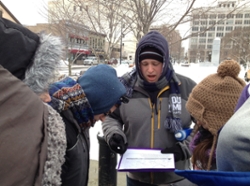Trading Places Opens Students' Eyes to Poverty During Brutal Week of Winter

The winter storm Juno walloped several states with heavy snow, high winds and coastal flooding – and provided a strong dose of the reality of being homeless to University of Scranton students who returned from semester break early to participate in an intense, week-long poverty simulation.
Sixteen students began the first day and night of the program called Trading Places by sleeping outside the DeNaples Center. That is least until the cardboard shelters the students erected gave way and project leader Patricia Vaccaro, director of the University’s Center for Service and Social Justice, gave in, allowing her charges to spend the overnight hours on the upper floor of the DeNaples Student Center, an experience that still proved educational.
“Our cardboard was soaked. Our tarps collapsed,” said sophomore accounting major Megan Calascibetta, of Hampton, New Jersey. Once inside, she quickly fell asleep under a table in the student center while the lights remained on, as they might in a shelter.
And their experience was just beginning.
“We woke up in the morning, and there was three inches of snow,” said freshman occupational-therapy major Bridget Fasciani of Long Island, New York.
In other words, perfect conditions under which to be sent back to the streets from with a “scavenger list” of items to accomplish – such as using public transportation to pick up job applications and visiting the welfare office and public library, where another reality hit.
“We realized you need a library card,” said Nicholas Lock, a sophomore counseling and human services major from Galeton. “A homeless person might not have identification and therefore might not be able to get a library card.”
Or even something to carry around what few possessions they might have.
“We were actually denied a plastic bag,” Calascibetta said, describing how students visited local stores and were told they could not have a bag unless a purchase was made.
They also hunted for places to stay warm and eat, such as St. Peter’s Cathedral on Wyoming Avenue, where they attended Mass, and the St. Francis of Assisi Soup Kitchen on Penn Avenue, where they ate.
On Tuesday, shopping on an extremely tight budget became another eye-opening experience.
The students were sent to Redner’s Warehouse Market in Scranton with $1 apiece to buy lunch. That dollar is roughly the amount of money welfare recipients have to spend per person per meal.
The students pooled their money to have $11 to buy food to share, purchasing store-brand peanut butter, jelly, two bunches of bananas and a bag of carrots.
The students had 29 cents to spare and many more talking points to discuss back on campus.
Was the larger jar of peanut butter a better value than the smaller even though the price was steeper? Were the choices made healthy?
Vaccaro asked about the decision to buy white bread, which Zack Tamimi, a sophomore political science major from Clarks Summit, explained. Whole-wheat bread was “a lot more expensive,” he said.
Trading Places is the brainchild of Vaccaro who developed the program and offered the program for the first time after a University student – Nick Longobardi of Floral Park, New York – asked if something could be done for students during the last week of winter break.
In addition to the simulation exercises, the program also included reflection and service. The students cooked meals for Scranton’s Community Intervention Center on Wednesday and revisited the St. Francis of Assisi Soup Kitchen, this time as volunteer servers, on Thursday.
View media stories about the initiative here: